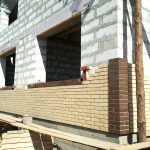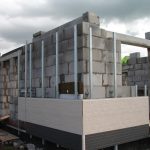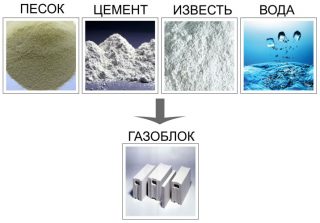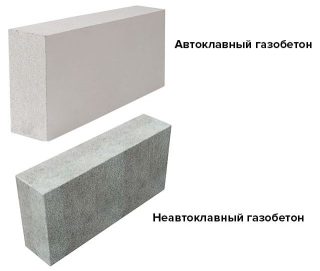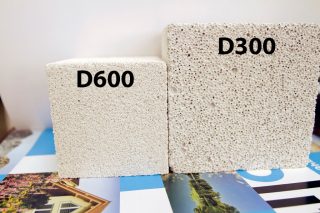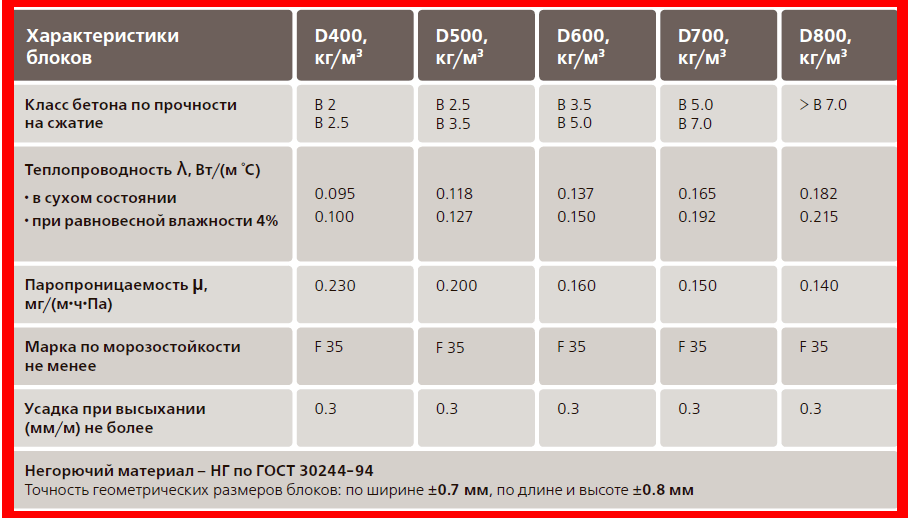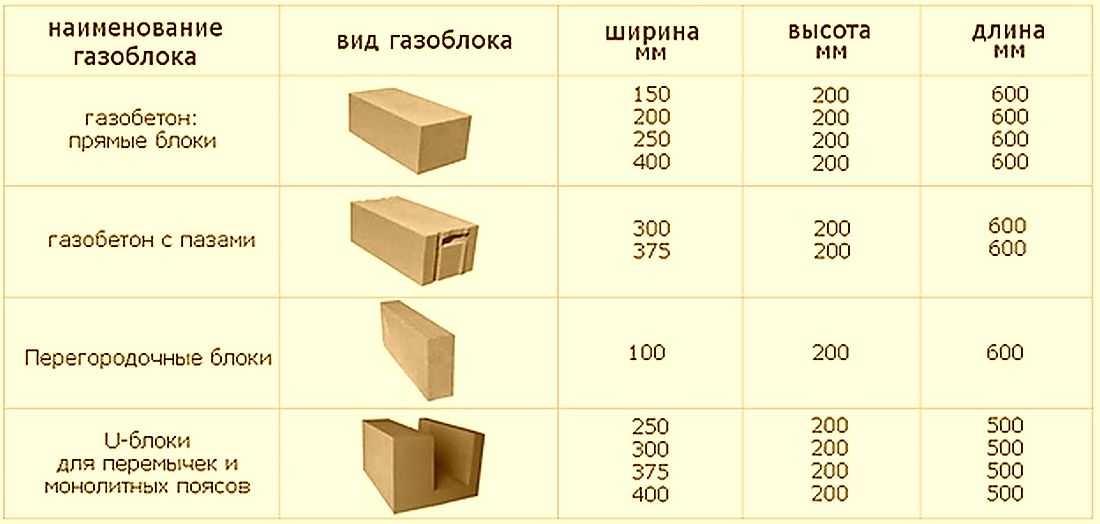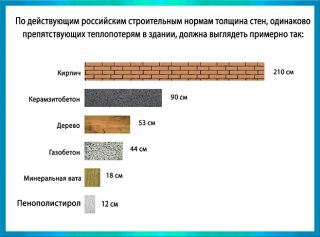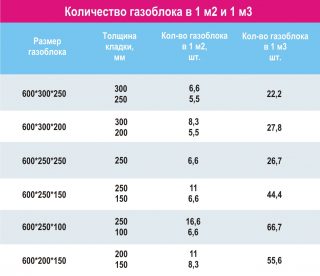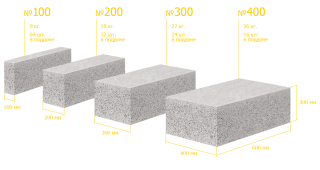Aerated concrete is classified as aerated concrete. The porous material has favorable characteristics in relation to an acceptable price, and its low thermal conductivity saves on energy resources. The sizes of the gas block are different, they depend on the brand, density, climate in the construction area. Dimensions affect the number of elements on the pallet, their number in the square and cubic meter of the wall.
- Description of aerated concrete
- Material production
- Comparison of aerated concrete and foam concrete
- Varieties and brands of aerated concrete blocks
- Standard dimensions, weight, sound transmission
- Strength and thermal conductivity
- Number of pieces in 1 cubic meter and pallet
- Rules for choosing aerated concrete blocks for construction
Description of aerated concrete
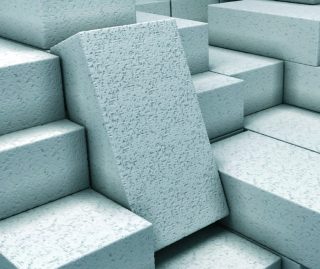
Blocks are different regular rectangular shape, them easy to cut with a hand saw... The size of one stone is equal to four standard bricks, therefore, the time of work is reduced compared to conventional masonry. Material does not sit down after the end of construction, the dimensions of the wall are reduced only by 0,2 – 0,5%, which can be attributed to minor changes (wooden buildings sit down by up to 15%).
Blocks are produced in perfectly smooth shapes, while the specificity of the expansion of gas bubbles gives clear dimensions of the product, almost without deviations. The wall is flat, no alignment is required in front of the interior and exterior cladding. Without finishing the walls are unattractive light grayso they are decorated.
Types of finishing of aerated concrete walls:
- Plastering and painting surface. Reinforced mesh is used to prevent mortar flaking and cracking. The layer is applied thin, thanks to the flat wall, painted on top with acrylic, latex, pentaphthalic compounds.
- Facing with tiles, facing bricks... The finish will last a long time if you also apply the mesh in a solution. The layer should have a base in the form of an additional foundation strip or beam. The minimum height of a tiled wall should not be higher than 15 meters.
- Ventilated curtain wall... Use metal, wood, vinyl, or cement siding. At the same time, they arrange insulation, waterproofing.
The installation of the hinged finish is combined with the device of the ventilated gap between the layers. The holes are brought out to the plane of the base, aligned with the line of the cornice. Their total quadrature is taken on the basis that 75 cm² for every 20 m² of vertical fence... The holes are covered with wind and vapor protection films.
Material production
Density products depends on the amount of blowing agent, but always get a flat surface of stones, without deviations in size. The density of aerated concrete affects the strength, hardness, thermal conductivity.
- Autoclave. High pressure is combined with steam treatment (+ 200 ° C) for 12 hours... The texture is homogeneous, the bearing capacity increases (not less 28 kgf / m³), specific thermal conductivity (at the level of 0.1 - 0.19 W m · K). Walls in one row effectively protect against heat loss.
- Non-autoclave. The mixture is placed in molds, a blowing agent is introduced, hardening takes place in a natural environment without pressure and high temperature. This method can be used to make gas blocks with your own hands. The strength of the material does not exceed 12 kgf / m²... Blocks coming out of a non-autoclave line shrink up to 2 - 3 mm in the walls.
As gasifier take aluminum powder together with lye... Metal corrosion occurs, hydrogen is released, it swells up the concrete mixture.
With the autoclave method, a set of various equipment is used, therefore, such products are more expensive, and small batches are unprofitable for the enterprise.
The dimensions of aerated concrete blocks are regulated by GOST, so all elements are normal.
Comparison of aerated concrete and foam concrete
Both materials belong to the class porous lightweight concrete. The difference consists of bubble formation method inside the thickness of the solution. Technological differences lead to the appearance of different properties.
Inside the raw material for the production of foam concrete is introduced foaming agent... The result is closed bubbles, which solidify in the foamed mass. The cavities limited from each other do not provide an opportunity for water absorption.
In aerated concrete, bubbles are formed under the influence gasifier, so the bubbling takes some time. The gases form longitudinal passages in the swollen solution, which not isolated from each other... Such a structure is saturated with water through wire channels.
There are other dissimilar signs:
- if we take the same grades of materials, then aerated concrete will be stronger, about 2 times, therefore, less reinforcement will be needed when building walls;
- heterogeneous structure leads to the fact that aerated concrete conducts more heat, and foam concrete better protects from the cold;
- due to closed pores foam concrete does not "breathe" well, and in houses made of aerated concrete, an acceptable microclimate is maintained;
- the weight of the gas block and the foam block is about the same.

Varieties and brands of aerated concrete blocks
Modern production supplies homogeneous aerated concrete, which is more durable than artisanal production. For example, B400 grade material can be classified as B2.5 class or only up to B1.5 (obsolete production). The numbers in the class designation indicate that 1 mm² of aerated concrete withstands a compressive force of 2.5 Newtons (1 cm² holds 25 kg).
Building materials are distinguished:
- structural, grades D900 - D1200, compressive strength class - B3.5 - B20, withstands a load of 46 - 262 kg / cm², vapor permeability 0.13 - 0.11 mg / m · h · Pa;
- heat insulating, grades D300 - D400, strength class - В0.75 - В2.5, declared exposure - 10 - 32 kg / cm², vapor permeability 0.23 - 0.26 mg / m · h · Pa;
- heat-insulating and structural D500 - D900, strength class B1.5 - B10, withstands 25 - 130 kg / cm², vapor permeability 0.14 - 0.2 mg / m · h · Pa.
In production, two variants of silica are used. First presupposes the use of finely ground quartz and other hard sand... In second case use waste after the manufacture of environmentally friendly industrial products... For example, ash after hydraulic removal, secondary raw materials after ore dressing, ash from thermal power plants, residues of ferroalloys.
Standard dimensions, weight, sound transmission
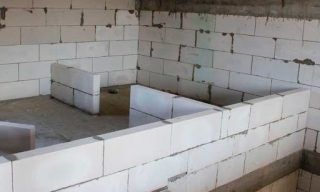
Aerated concrete differs from standard concrete less naturally occurring radioactivity... This is explained by raw materials do not include mica and crushed granitethat have natural radiation.
Weight of 1 m³ blocks aerated concrete, depending on the brand:
- D300, D400 - 300 and 400 kg / m³;
- D500, D600 - 500 and 600 kg / m³;
- D700, D800 - 700 and 800 kg / m³;
- D1000, D1100, D1200 - 1000, 11000, 1200 kg / m³.
The weight of one piece is found by dividing the weight of 1 m³ by the number of gas blocks in 1 cube... The second option is to divide the mass of the factory packaging by the number of products in it. Typically, when designing, an indicator for 1 m³ is used.
Sound insulation is measured in dB (decibels), the value shows what level the sounds do not pass through the thickness of the wall:
- D300 grade insulates 29 dB with a wall thickness of 100 mm, 35 dB with a wall thickness of 150 mm, 40 dB - 200 mm, 46 dB - 300 mm;
- grade D400, respectively: 31 DB - 100 mm, 41 DB - 150 mm, 43 DB - 200 mm, 50 DB - 300 mm;
- D600 grade - 36 DB - 100 mm, 44 DB - 150 mm, 47 DB - 200 mm, 55 DB - 300 mm.
Dimensions of aerated concrete are produced: in length - 600 and 625 mm, in width they make 500, 400, 350, 300, 200, 150, 100 and 75 mm, in height - 250 and 200 mm.
Strength and thermal conductivity
When horizontal, reinforcement is installed in each 3 - 4 row of blocks, the exact ratio is determined by the density of the building material and its bearing capacity. Use metal smooth and grooved rods... At the corners of the masonry of walls and partitions, overlapping reinforcement is installed or a stamping mesh is used.
The material shows high thermal conductivity due to its cellular structure. The wall indicator of 40 cm is equal to similar value brick walls half a meter thick... The thermal conductivity of aerated concrete is 4 times less than that of ceramic stones.
For buildings with a height of no more than 1 - 1.5 floors, thermal conductivity becomes the determining factor when choosing. For taller buildings, the strength of the material gains value, and the heat-saving properties are increased by additional insulation from the cold.
Number of pieces in 1 cubic meter and pallet
Number of blocks:
- the size of the stone is 75 x 200 x 600, the number in a cube is 111.11 pieces, from one m³ comes 13.33 m² of the wall;
- size 100 x 200 x 600, quantity - 83.33 pieces, comes out 10 m²;
- 120 x 200 x 600 - 69.44 pieces, 8.33 m²;
- 150 x 200 x 600 - 55.55 pieces, 6.67 m²;
- 200 x 200 x 600 - 41.66 pieces, 5 m²;
- 250 x 200 x 600 - 33.33 pieces, 4.0 m²;
- 300 x 200 x 600 - 27.77 pieces, 3.33 m²;
- 360 x 200 x 600 - 23.16 pieces, 2.78 m²;
- 400 x 200 x 600 - 20.83 pieces, 2.5 m²;
- 500 x 200 x 600 - 16.66 pieces, 2.0 m².
Counting data:
- block size 75 x 200 x 600, on a pallet 1.62 m³ or 180 pieces;
- size 100 x 200 x 600, 2.16 m³, 180 pieces;
- 120 x 200 x 600 - 2.16 m³, 150 pieces;
- 150 x 200 x 600 - 2.16 m³, 120 pieces;
- 200 x 200 x 600 - 2.16 m³, 90 pieces;
- 250 x 200 x 600 - 2.16 m³, 70 pieces;
- 300 x 200 x 600 - 2.16 m³, 60 pieces;
- 360 x 200 x 600 - 2.16 m³, 50 pieces;
- 400 x 200 x 600 - 1.92 m³, 40 pieces;
- 500 x 200 x 600 - 2.4 m³, 40 pcs.
Quantities are for standard pallets. If the company uses other parameters of the pallets, find out the indicators for each case separately from the supplier or sales representative.
Rules for choosing aerated concrete blocks for construction
Thickness selection:
- for carriers structures - not less than 300 mm;
- self-supporting - not less than 300 mm;
- finishing in the form of an insulating layer - not less than 100 mm.
According to the standards deviations from dimensions in thickness should not be more than 1 mm, height - 2 mm, length - 3 mm... The consumption of glue mixture or mortar for masonry depends on this parameter, there will also be an overrun of plaster or putty.
When choosing, they rely on the technical characteristics of a certain type of aerated concrete stones, therefore the seller provides the necessary documentation from the manufacturer listing the indicators and sizes. You also need to require a quality certificate for products.

